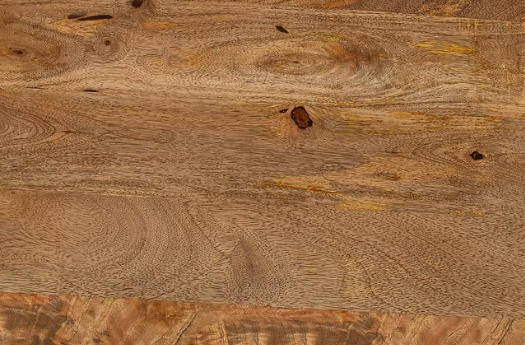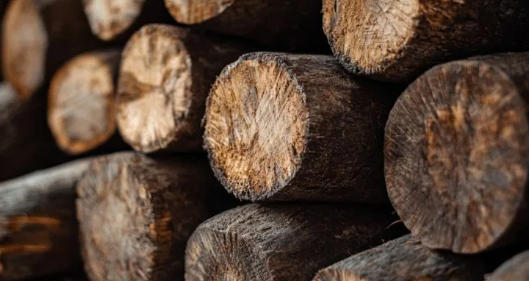










Content Menu
● Botanical Source and Growth Cycle
● Physical Characteristics of Mango Wood
● Comparison with Other Common Hardwoods
● Sustainability and Environmental Benefits
● Trade and Global Market Perspective
● Durability and Performance Evaluation
● Maintenance and Long-Term Care
● Mango Wood in Sustainable Design Trends
● FAQ
>> 1. Is mango wood water-resistant?
>> 2. How long does mango wood furniture last?
>> 3. Can mango wood be used outdoors?
>> 4. Is mango wood sustainable compared to teak?
>> 5. Can mango wood be refinished or repainted?
As the world moves toward sustainable interior design and eco-conscious building materials, consumers and designers are showing growing interest in alternative hardwoods. One such material — mango wood — has become widely popular in the global furniture industry for its attractive look, moderate strength, and eco-friendly production cycle.
Still, many people ask: Is mango wood truly a hardwood?
The answer is yes — mango wood belongs to the botanical hardwood family, but with a more balanced density that combines durability with easy workability. Understanding its properties helps consumers and manufacturers make informed choices for interior décor, carpentry, and architectural applications.

The classification of “hardwood” doesn't depend solely on a wood's rigidity. Instead, it's a botanical distinction between two types of trees:
- Hardwoods: Derived from angiosperms, or flowering trees with broad leaves and enclosed seeds. Examples include oak, walnut, and mango.
- Softwoods: Sourced from gymnosperms, such as pine, spruce, and cedar, with needle-like leaves and uncovered seeds.
Hardwoods typically grow more slowly, producing denser and more complex cell structures that make them durable and suitable for heavy-duty use. Although mango trees grow relatively fast compared to traditional hardwoods, their cellular anatomy aligns with angiosperm traits — classifying them scientifically as hardwood.
Mango trees, scientifically known as Mangifera indica, originate from South Asia, especially India, but are now widely cultivated across tropical and subtropical regions. The trees are primarily grown for fruit, and once their yield decreases after about 15–20 years, they are cut down and replaced.
Instead of wasting the old trees, manufacturers process their trunks and branches into lumber. This dual-purpose cultivation creates an efficient and eco-friendly timber source. The wood harvested from these trees is relatively dense, colorful, and smooth-grained — ideal for furniture and decorative work.
The global mango wood supply chain thrives mainly in India, Thailand, Indonesia, and Vietnam, where mango plantations are vast. This structure provides both economic and environmental benefits, creating employment in rural communities and reducing the pressure on endangered forest hardwoods like teak and mahogany.
Mango wood's visual and structural characteristics make it an appealing choice for builders and artisans:
- Color: Ranges from light golden-brown to creamy beige with streaks of yellow, pink, or black due to natural spalting.
- Texture: Fine to medium, ensuring a soft touch and ease in polishing.
- Grain: Usually straight but occasionally interlocked, giving furniture a distinctive, artistic look.
- Luster: Naturally shiny, often enhanced with oils or wax finishes.
- Density: Moderately dense with values around 560–700 kg/m³.
Because mango wood dries relatively quickly after harvest, it minimizes warping and cracking compared to other tropical hardwoods. The slight natural irregularities in color and grain further enhance its uniqueness — no two mango wood pieces look exactly alike.
On the Janka hardness scale, mango wood scores approximately 1,070 lbf (4,760 N). It falls between the hardness levels of teak and oak, offering an ideal balance between toughness and flexibility.
| Wood Type | Janka Hardness (lbf) | Density (kg/m³) | Elastic Modulus (GPa) |
|---|---|---|---|
| Mango Wood | 1,070 | 650 | 9.3 |
| Teak | 1,070 | 660 | 10.2 |
| Oak (Red) | 1,290 | 700 | 12.0 |
| Maple (Hard) | 1,450 | 755 | 12.6 |
| Pine (White) | 380 | 450 | 8.1 |
This data indicates that mango wood performs comparably to teak in hardness and elasticity, offering excellent strength-to-weight ratio while being more affordable and renewable.
Mango wood ranks high in workability, making it a favorite among carpenters and industrial manufacturers alike.
- Cutting and shaping: Its moderate hardness allows smooth sawing and carving.
- Nailing and screwing: Minimal risk of splitting; strong fastener hold.
- Adhesion: Suitable for glues and joints, common in assembly lines.
- Finishing: Accepts stains, oils, paints, and polish evenly, allowing customization from rustic to luxury looks.
However, due to its organic moisture content, mango wood must be properly kiln-dried before use. The drying process stabilizes the internal moisture, preventing shrinkage or distortion after crafting.
Mango wood's versatility enables both artisanal and industrial-scale applications:
- Indoor Furniture: Coffee tables, wardrobes, dining sets, dressers, and bed frames.
- Architectural Elements: Wall panels, interior doors, and cabinetry.
- Decorative Items: Candle holders, bowls, trays, picture frames, and mirror borders.
- Woodcrafts: Hand-carved statues, sculptures, and handicrafts exported globally from India and Thailand.
- Commercial Interiors: Eco-conscious office furniture and boutique store fixtures.
- Flooring and Cladding: When properly treated, mango wood offers warm color and charm for interiors.
This broad usage reflects mango wood's aesthetic adaptability and functional reliability across traditional and modern design contexts.
| Property | Mango Wood | Teak | Acacia | Oak |
|---|---|---|---|---|
| Color | Golden to light brown | Mid to dark brown | Medium brown | Pale tan |
| Grain | Unique, irregular | Straight, uniform | Wavy or interlocked | Open-grained |
| Workability | Excellent | Moderate | Moderate | Moderate |
| Water Resistance | Moderate | High | High | Medium |
| Cost | Low-Medium | High | Medium | Medium |
| Sustainability | Very High | Medium | Medium | Moderate |
Mango wood thus stands out as a budget-friendly and eco-positive option while maintaining a look and performance close to more famous hardwoods.

Sustainability defines mango wood's modern appeal. Unlike many exotic hardwoods that contribute to deforestation, mango trees follow a recyclable growth cycle:
1. Trees produce fruit for 15–20 years.
2. When productivity declines, trees are replaced with new saplings.
3. Old trees are cut for lumber rather than wasted.
This cycle aligns with green manufacturing and FSC (Forest Stewardship Council) principles, maximizing land use and reducing resource depletion.
Additionally, mango wood plantations store carbon dioxide and stabilize soil ecosystems, supporting national reforestation and carbon-neutral goals in regions like India and Indonesia.
The global popularity of mango wood has expanded rapidly over the last decade. It is now a mainstream export product in markets such as Europe, North America, and Australia, driven by the rise of ethical consumption and sustainable interior design trends.
Key exporters include:
- India — leading producer of handcrafted and mass-produced mango wood furniture.
- Thailand and Vietnam — known for fine finishing and modern design.
- Indonesia — integrates mango wood with reclaimed teak for mixed furniture sets.
Global buyers increasingly demand certified mango wood products that ensure compliant harvesting, traceability, and low chemical emissions during processing.
Although mango wood is naturally strong, several treatments can enhance performance:
- Oil Treatment: Linseed or tung oil provides deeper color and moisture resistance.
- Lacquer Finish: Adds surface protection and glossy aesthetic.
- Anti-Termite Coating: Prevents pest infestation in warm, humid conditions.
- UV Sealers: Used for pieces near sunlight to prevent fading.
When treated properly, well-made mango wood furniture lasts over two decades with minimal structural degradation.
Designers often choose mango wood for its distinctive grain and varied tones. Each plank features a blend of light and dark shades, creating organic contrasts that complement Scandinavian, industrial, and rustic interiors.
Moreover, its surface easily responds to treatments like distressing, bleaching, or staining, making it adaptable to numerous global décor trends. In contemporary design studios, mango wood is often mixed with metal legs, rattan panels, or glass tops to form eco-modern combinations that appeal to environmentally aware consumers.
Preserving mango wood's finish and stability requires consistent care:
- Dust regularly: Soft cloth cleaning prevents buildup that dulls surfaces.
- Avoid excess moisture: Wipe immediately after spills to prevent staining.
- Keep away from heat: Avoid placing furniture next to radiators or fireplaces.
- Re-oil frequently: Reapply protective oils every 6–12 months to maintain shine.
- Level humidity: Use room humidifiers in overly dry climates to avoid cracking.
When maintained well, mango wood ages beautifully with a natural golden patina, adding depth and warmth to interiors over the years.
In modern architecture and product design, mango wood has become synonymous with eco-luxury. Its widespread availability, renewable sourcing, and artisanal crafting traditions make it a symbol of responsible consumerism. Many European designers now integrate it into “green” product lines certified under sustainable procurement standards.
In addition, its minimal carbon footprint throughout production — from local harvesting to short-distance processing — makes mango wood one of the most environmentally positive hardwoods available commercially.
Mango wood is unequivocally a hardwood — botanically, structurally, and functionally. It offers a rare combination of durability, beauty, and sustainability. Unlike slow-growing hardwoods that deplete natural forests, mango wood regenerates as part of agricultural recycling.
Its natural charm, ease of crafting, and long lifespan make it ideal for both residential and commercial furniture production. Whether used in rustic farm tables, elegant cabinets, or decorative crafts, mango wood delivers value and eco-conscious elegance that align perfectly with modern lifestyle priorities.

Mango wood offers moderate resistance but is not fully waterproof. Applying protective oil or sealant prevents swelling and improves longevity in humid environments.
Properly kiln-dried and maintained mango wood furniture typically lasts 20–25 years, depending on environmental conditions.
Yes, but outdoor use requires protective finishes like polyurethane or marine varnish. Furniture should also be covered or shaded to avoid direct sunlight and rain.
Mango wood is more sustainable, as it's a by-product of fruit farming. Teak plantations require longer growth cycles and more water resources.
Absolutely. Its smooth, porous surface readily accepts new finishes, oils, and stains — making it easy to restore or repurpose older furniture.